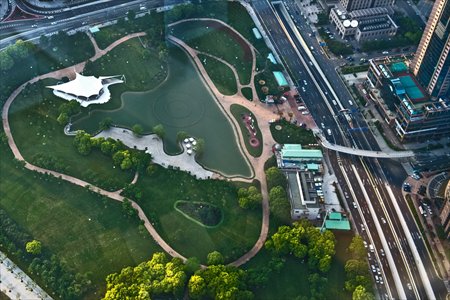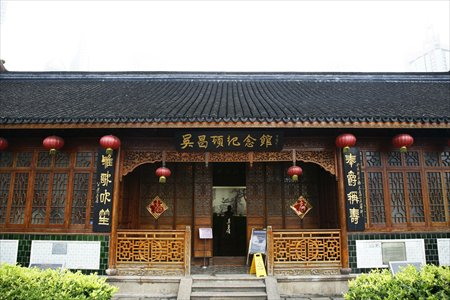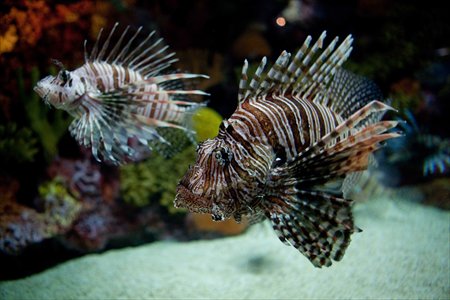Leisurely Lujiazui
The first stop on metro Line 2's eastern section that runs through Pudong New Area is Lujiazui Station. Located at the heart of the city's Lujiazui financial hub, the subway station was put into use in late 1999 and serves as a gateway to a slew of urban landmarks ranging from skyscrapers to scenic spots. The Global Times recently hopped on a Line 2 train and stopped at the Lujiazui Station to navigate the sprawling, flourishing financial zone and its nearby attractions.
The big threes
A 10-minute walk from exit 4 leads to the area's famous Three Brothers - a trio of imposing buildings that were built to define the city's ever-growing skyline. The three towering architectures are the 632-meter-tall Shanghai Tower, the 492-meter-high Shanghai World Financial Center, and the 421-meter Jin Mao Tower.
The main structure of the still under-construction Shanghai Tower was recently topped off on August 3 and now stands at some 580 meters tall. Slated for opening in 2015, the edifice is proudly known as the tallest building in China and second only to Dubai's Burj Khalifa in the world.
Built at a whopping cost of 15 billion yuan ($2.45 billion), the Shanghai Tower is the brainchild of the 52-year-old American architectural designer Marshall Strabala, the same man behind the Burj Khalifa, which stands at 829 meters.
Construction began in 2008 and upon completion, the over-120-story tower will house a luxury hotel, retail space, offices, cultural and other public facilities. Even more noteworthy is that the building is designed to be one of the country's most eco-friendly skyscrapers, featuring thermal insulation and wind turbines to make best use of natural resources and minimize energy consumption.
The Shanghai Tower and its two siblings have been dubbed a three-piece household utensil set because of their uncanny shapes and facades.
Chinese Internet users have joked that the Shanghai Tower looks like an eggbeater, the Shanghai World Financial Center is a bottle opener and the Jin Mao Tower resembles a needle.

Lujiazui Central Greenland Photos: CFP
An evergreen space
Nestled at the base of the Jin Mao Tower is the Lujiazui Central Greenland (picutred below, 15 Lujiazui Road East, 5887-9964), a popular park in Shanghai which is home to the city's largest open lawn - its central green space is covered by a 65,000-square-meter, all-year-round-green grass turf.
Opened to the public in 1997 and covering a total area of 100,000 square meters, the park boasts hundreds of varieties of trees and flowers, including weeping willows, magnolia, gingko and cedar, and thus is often referred to as the "green lung" of Shanghai.
Visitors to the park are greeted at the entrance by a gigantic steel sculpture titled Spring, which is comprised of eight steel flowers in full bloom. At the center of the park lies a large man-made lake which resembles a geographic silhouette of Pudong New Area. The tranquil lake is surrounded by a winding pathway which is formed to outline a magnolia, Shanghai's city flower.
Other key scenes of the park include a major lake fountain encircled by two subsidiary fountains, and a white, conch-shaped pavilion overlooking the lake view.
With the lush greenery and a serene environment, the Lujiazui Central Greenland offers a perfect mini getaway from the daily grind of hectic city life. It's also a favorite spot for newlyweds to take their wedding photos.

Wu Changshuo Memorial Hall
A hidden cultural institution
Next to the Lujiazui Central Greenland sits a hidden cultural institution, the Wu Changshuo Memorial Hall (picutred above, also at 15 Lujiazui Road East, 5878-6863), a private museum in memory of Wu Changshuo (1844-1927), a prominent figure in history of modern Chinese art.
Wu, a Zhejiang native, was renowned for his remarkable achievements in such diverse art forms as painting, calligraphy, poetry and seal carving. He seamlessly incorporated various artistic influences of the late Qing Dynasty (1644-1911) into his own works and pioneered a new painting genre that has inspired a whole generation of modern Chinese artists.
The memorial hall was moved from its original site inside the Huaxia Cultural Tourism Development Zone in Pudong New Area to the current location in May 2010. Housed in a century-old private residence of classical Chinese architectural style, the 1,600-square-meter memorial hall features three major exhibition halls dedicated to showcasing Wu's life and masterpieces.
Of the museum's collection of about 700 delicate artworks, there are also showpieces created by heavyweights of China's modern art scene, including Qi Baishi, Xu Beihong, Zhang Daqian and Liu Haisu, all of whom were either instructed or influenced by Wu Changshuo.
The museum opens from 9:30 am to 4 pm daily and charges a 10 yuan admission fee for adults.

Shanghai Ocean Aquarium
A fun-filled family destination
A brief walk from exit 1 is the Shanghai Ocean Aquarium (pictured below, 1388 Lujiazui Ring Road, 5877-9988), a popular family destination. The largest of its kind in the city, the aquarium was built at a cost of $55 million and opened its doors in 2002.
Located just next to the city's most symbolic landmark, the Oriental Pearl Tower, the aquarium has nine zones themed around five continents and four oceans, and boasts a colossal collection of over 450 species of aquatic creatures from around the globe.
Each zone is designed to recreate the natural habitat of its marine life and to educate visitors about the various species.
The aquarium opens from 9 am to 6 pm daily with an admission fee of 160 yuan for adults and 110 yuan for children between 1 and 1.4 meters tall. The good news for budget-minded visitors is that the aquarium will offer a 50 percent discount to both adults and children during September 14 to 18 to coincide with Shanghai's annual tourism festival, which will run until October 6.